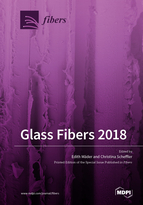Glass Fibers 2018
A special issue of Fibers (ISSN 2079-6439).
Deadline for manuscript submissions: closed (31 December 2018) | Viewed by 28314
Special Issue Editors
Interests: interfaces; surface energy, work of adhesion, adhesion strength; micromechanical tests; interphases; characterization of interphases using microthermal analysis; interphase characterization using scanning force microscopy; interphase characterization using single fiber cyclic load test; micro-macro relations in composites; continuous fiber reinforced thermoplastics made from commingled yarns using different textile preforms, studies of structure-property relations, mechanical performance influenced by interphases; continuous surface modification during glass fiber spinning (sizing); reinforced thermoplastics by compounding, injection molding, long fiber reinforced thermoplastics; commingled yarns for continuous fiber-reinforced thermoplastics; interphase design in fiber reinforced concrete; improving the aging behavior and enhancing the durability by interface modification (nanostructured sizing, polymer coatings)
Special Issues, Collections and Topics in MDPI journals
Special Issues, Collections and Topics in MDPI journals
Special Issue Information
Dear Colleagues,
Glass fibers are melt-spun, silica-based inorganic materials, and have been well known and comprehensively used for many years. Their main application is in glass fiber-reinforced composites, which accounts for more than 90% of all fiber-reinforced composites currently produced. Nevertheless, it is still challenging to improve fibers, interfaces and composites in key areas.
The objective of this Special Issue is to focus on actual research topics related to glass fibers comprising multifunctional nanostructured surfaces, which can lead from insulating to electrically conductive fibers and their interphases in composites are capable to uptake mechanical, chemical, humid, and thermal in situ sensing and photocatalytic functions. Glass fiber size includes lubricants, binders and/or coupling agents help to protect the filaments from failure during processing and cause the fibers to improve resin wetout and strengthening the adhesive bond at the fiber–matrix interface. The improvement of the compatibility of some size chemistries to the composites’ matrix is a key issue in resin wetout and adhesion strength.
Furthermore, the specific durability features of alkali-resistant glass fibers, acid-resistant special glass fibers, and basalt fibers are highlighted by the application of coatings. An inline spinning and comingling of glass filaments and polymeric filaments leads to easy-to-process continuous glass fiber-reinforced thermoplastic matrix composites. Finally, significant attention will be paid to recycling and re-use of glass fibers separated from composites at end-of-life.
Prof. Dr. Edith Maeder
Dr. Christina Scheffler
Guest Editors
Manuscript Submission Information
Manuscripts should be submitted online at www.mdpi.com by registering and logging in to this website. Once you are registered, click here to go to the submission form. Manuscripts can be submitted until the deadline. All submissions that pass pre-check are peer-reviewed. Accepted papers will be published continuously in the journal (as soon as accepted) and will be listed together on the special issue website. Research articles, review articles as well as short communications are invited. For planned papers, a title and short abstract (about 100 words) can be sent to the Editorial Office for announcement on this website.
Submitted manuscripts should not have been published previously, nor be under consideration for publication elsewhere (except conference proceedings papers). All manuscripts are thoroughly refereed through a single-blind peer-review process. A guide for authors and other relevant information for submission of manuscripts is available on the Instructions for Authors page. Fibers is an international peer-reviewed open access monthly journal published by MDPI.
Please visit the Instructions for Authors page before submitting a manuscript. The Article Processing Charge (APC) for publication in this open access journal is 2000 CHF (Swiss Francs). Submitted papers should be well formatted and use good English. Authors may use MDPI's English editing service prior to publication or during author revisions.
Keywords
- glass fibers
- sizing
- coating
- multifunctionality
- nanostructured surface
- composites
- interphase design
- interphase characterization
- durability
- basalt fibers
- inline commingling
- recycling







